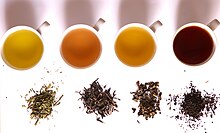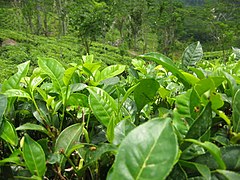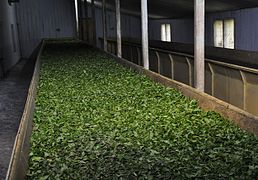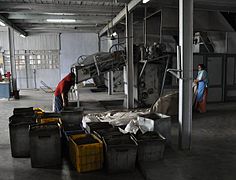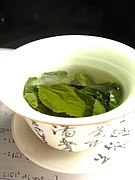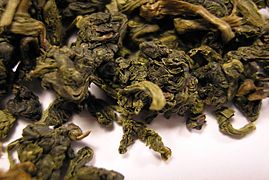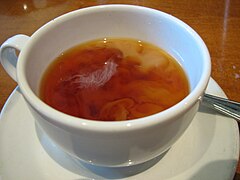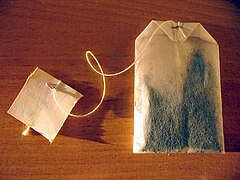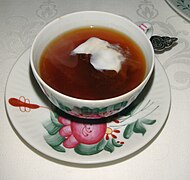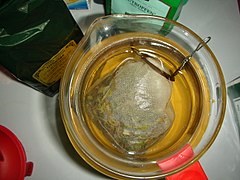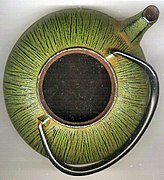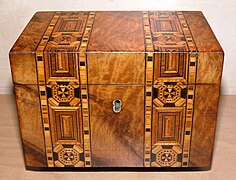tea
Tea ( Chinese 茶 , Pinyin chá , IPA ( standard Chinese) [ tʂʰɑ˧˥ ], Jyutping caa 4 , Pe̍h-ōe-jī tê ) in the true sense of the word is a hot infusion that is mainly made from the leaves and leaf buds of the Tea plant being prepared. Some special teas also contain stems ( kukicha ). Tea is a luxury item .
Depending on the part of the plant (most buds, leaves descending), tea contains up to 4.5% caffeine . In the 19th century, this active ingredient in tea was called "Thein" or "Teein". The drink was written with th as "Thee" until the spelling reform of 1901 .
In a broader sense, “tea” is a hot infusion that is made from different parts of different plants. This also includes herbal teas and fruit teas . Plant parts used are leaves, buds, flowers, fruits, stems, bark or roots, depending on the type of plant.
term
According to the entry in the German dictionary of the Brothers Grimm, the word tea was adopted from the Dutch thee into German in the 17th century . The common names tea , tea , thé etc. in western Europe come from the Minnan pronunciation of the Chinese character " 茶 ", because these countries received the leaves of the tea plant by sea from southern China . In countries that imported the leaves of the tea plant by land via northern China , such as Russia and Turkey (and thus also in most of the countries in eastern and southeastern Europe) as well as Persia and India , but also in seafaring Portugal , the word was used after the high Chinese pronunciation cha ( Chinese 茶 , pinyin chá ,; the pronunciation for Turkish çay and Russian чай is chai ), originally chaje ( 茶葉 / 茶叶 , cháyè - "tea leaves") adopted.
Since the early 18th century, the word tea has also been used for the infusion of dried components from other plants and denotes not only black and green tea , but also herbal and fruit teas . A similar situation prevails in other Germanic languages (for example English and Dutch). Also Turkish is çay : a generic term siyah çay 'black tea , bitki çayı , herbal' and meyve çayı , Fruit ' . In many other languages, however, this combination of different drinks under one term is unknown. In Spanish , té is just black tea, everything else is called infusión . The situation is similar in France: thé is black or green tea, while herbal tea is called tisane (or infusion ); a word that is sometimes used in English. In French-speaking Switzerland, on the other hand, the word thé is also used for herbal and fruit tea, as it is in German.
Contrary to common usage, according to ISO standard 3720, only leaves and infusions of the tea plant (Camellia sinensis) can be referred to as "tea". Infusions of herbs, fruits or spices are considered "tea-like products" according to this standard.
Cultivation
The tea plant ( Camellia sinensis) was initially only known in China. In 1823 wild plants were discovered in Assam (India), but they were not correctly identified for a long time. It was not until 1834 that this species was cultivated and crossed with other species. The hybrids were soon bred and grown in other regions suitable for them. Tea bushes can be grown from seeds or from cuttings , the latter is the rule today. The young plants are carefully cared for in their own nurseries ( nursery bags with good mother soil ) for nine months. 12,000 to 13,000 seedlings are required per hectare. After that, the plant must continue to grow for three to six years before it can be harvested for the first time. The yield of one hectare is an average of 1500 kg of ready-to-brew tea.
The "life expectancy" of the Indian tea bushes is 30 to 50 years, while the Chinese species can live up to 100 years. The cuttings are obtained from the shoots of particularly strong and high-yielding mother plants. Like all other crops, tea is also grown . Like all camellias , the tea plant is conditionally frost-hardy .
Economical meaning
The largest tea producers
According to the FAO, 6.4 million tons of tea were harvested worldwide in 2018 . The world's ten largest tea producers together harvested 90.5% of the total in 2018.
| rank | country | Quantity (in t ) |
|---|---|---|
| 1 |
|
2,610,400 |
| 2 |
|
1,344,827 |
| 3 |
|
492.990 |
| 4th |
|
303.840 |
| 5 |
|
270,000 |
| 6th |
|
270,000 |
| 7th |
|
141,342 |
| 8th |
|
109,357 |
| 9 |
|
109,357 |
| 10 |
|
83.052 |
| world | 6,337,969 |
The largest tea exporters
In 2016, the global export volume was 1,701,057 tons. The largest tea exporters were:
-
 People's Republic of China with 328,699 t
People's Republic of China with 328,699 t -
 Kenya with 293,231 t
Kenya with 293,231 t -
 Sri Lanka with 286,760 t
Sri Lanka with 286,760 t
The largest tea importers
Worldwide were 2016
-
 Pakistan with 184,905 t
Pakistan with 184,905 t -
 Russia with 164,398 t
Russia with 164,398 t -
 United States with 131,066 t
United States with 131,066 t
the largest tea importers.
During this period, Germany imported 57,835 t of tea, making it 8th among the largest importers.
The largest tea consumers in Europe
On average, the five countries with the highest per capita tea consumption in Europe, as of 2018:
| rank | country | Quantity (in l / head / year) |
|---|---|---|
| 1 |
|
300 |
| 2 |
|
187 |
| 3 |
|
184 |
| 4th |
|
103 |
| 5 |
|
52 |
| 6th |
|
36 |
Manufacturing
Traditional production
In the traditional production of black tea, called orthodox tea production, the tea leaves go through five stages: withering , so that the leaves become soft and tender, rolling , sifting, oxidation and finally drying ( firing ) .
To soften the leaves after picking, they used to be placed in the sun for two hours. Wilting hurdles were later used in special halls with a temperature of 20 to 22 ° C. The wilting process then took up to 24 hours. Today so-called withering tunnels are mostly used, which the tea leaves pass through on conveyor belts. The strength of the wilting has an effect (inversely) on the degree of oxidation that can be achieved later.
Rolling is done by machine today and takes about half an hour. The cells in the leaves are broken open, releasing essential oils . Then the tea leaves are sorted according to quality. During the oxidation process, moisture is returned to them by artificially generated high humidity of over 90% at exactly 22 ° C, in order to set the chemical processes in motion. During the oxidation, heat is generated, the temperature of the leaves is measured every 15 minutes and stopped immediately after the maximum temperature of 29 ° C has been reached by drying. If this point in time is missed, the tea leaves no longer have any aroma and are considered "burnt". In tea production, oxidation is called fermentation .
Hot air is used for drying in machines. For Ceylon , 20 minutes at 90 ° C is enough, Assam takes much longer. The tea is then immediately cooled again.
In Turkey , six kilograms of tea leaves are used to make one kilogram of black tea.
In contrast to black tea, there is no oxidation with green tea. Half-fermented tea (oolong) is also produced in China and India , Sri Lanka and Taiwan and, more recently, in Africa.
Individual tea plantations, in which special tea specialties are made, still produce according to old methods, in which the wilting takes place in the sun. It is rolled by hand, the oxidation takes place in woven baskets.
CTC production
CTC stands for C rushing , Breaking ' , T earing , Tearing' and C urling , rollers' . With this modern method, which is used in large production plants, the tea leaves are broken, torn and rolled by machine in one operation after they have wilted. Sometimes several CTC machines are switched one behind the other in order to obtain even finer tea powder. This is followed by oxidation, drying and sorting. This method is used to produce teas primarily for use in tea bags .
Types of tea & types of tea
Types of tea
The original method of making tea beverages is the use of fresh tea leaves, plucked directly from the bush, and placed in hot water. Prepared in this way, tea tastes significantly different than with dried leaves. Fresh tea leaves cannot be stored for a long time, ferment by themselves or spoil due to the activity of undesirable microorganisms. Therefore, the targeted fermentation and drying was developed so that the tea can be stored. Depending on the procedure and the starting material, numerous different taste qualities are created. Today, a distinction is made between four traditional forms, which differ mainly in the degree of oxidation:
- Green tea - there is no intentional oxidation. In traditional production, the tea is withered in iron pans over the fire after harvest and then dried. In industrial production, this is done in large, stirred containers.
- White tea - so called because the hairs on the underside of the leaf give the dried tea leaves a white-silver color. No intentional oxidation. Young shoots are harvested and dried (like hay). Only top quality teas are suitable for the production of white tea.
- Oolong - is partially oxidized. After the harvest, the tea is shaken in wicker baskets, the escaping juice reacts with the oxygen in the air. This process is stopped by heating in iron pans.
- In East Asia, black tea is called red tea ( 紅茶 , Chinese Hóngchá , Japanese kōcha ) - complete oxidation. Like Oolong, but it doesn't stop the oxidation process. It takes a long time for the tea to finish drying.
In addition to these four classic production methods, there are other, less common specialties
- Post-fermented tea (for example Pu-Erh tea ) is called black tea ( 黑茶 , Chinese Hēichá ) in Asia and is in fact much darker in color than the black tea drunk in Europe - it is colored in the cup more like coffee. It is a formerly green to oolong-like tea, which is then matured for a few months to several years.
- Yellow tea is a specialty only produced in China. It is a tea that is harvested like white tea, but not processed immediately after harvest. So there is minimal oxidation. It is one of the most expensive tea specialties available. Sometimes it is assigned to the green teas.
Teas
Countless types of tea are assigned to the various types of tea, for example:
- Green tea - Gunpowder , Sencha , Chun Mee , ...
- White tea - Baihao Yinzhen , Pai Mu Dan , ...
- Oolong tea - Dongding Oolong, Tieguanyin (also Tikuanyin), ...
- Black tea - Darjeeling , Assam , ...
- Pu'erh tea - Pu'erh Tuocha, Palace of Pu'erh, ...
- Yellow tea - Junshan Yinzhen, ...
The most famous teas in Europe are the Assam , Ceylon and Darjeeling black tea varieties named after their growing areas . But tea is still produced in many other areas. The East Indian Assam tea comes from the largest cultivation area in the world and is a typical highland tea with a strong aroma. The tart, strong Ceylon is grown in Sri Lanka , the world's third largest growing area. Both types are often found in tea blends and are insensitive to hard water . The delicate, yellow Darjeeling grows on the southern slopes of the Himalayas around the district capital of the same name in northern West Bengal at an altitude of over 2000 m. He is more sensitive to hard water. Formosa mostly refers to green or oolong teas from the island of Taiwan.
Sorting
A number of abbreviations are commonly used in stores, which not only provide information about the type of tea but also about the leaf size. In the production common in India, the leaves are mechanically sorted according to size using vibrating screens. From this, from the appearance of the leaves and from the types of tea, the following names result:
General
- Orange - not a reference to color, but to royal quality (Oranien - oranje)
- Pekoe - the tender young leaves of a tea plant (Chinese: "white fluff")
- Broken - small-leaved teas, in contrast to the whole leaf (English: "broken")
- Fannings - small tea particles (~ 1 mm), exclusively for tea bags
- Dust - "tea dust", exclusively for tea bags
- Tippy / Tip - leaf tips of tender, young tea leaves that do not turn so dark in color when brewed
- Throw-in - stalks or tea wood (are partly used)
- Clonal - Teas that are picked from "clones"
- Infusion - tea leaves after infusion
Leaf teas
- FOP - Flowery Orange Pekoe: easy grading for Indian teas
- GFOP - Golden Flowery Orange Pekoe
- OP - Orange Pekoe
- P - Pekoe (as Ceylon tea also under the name BOPI, spherical leaf)
- TGFOP - Tippy Golden Flowery Orange Pekoe: Main grade for Darjeeling and Assam
- FTGFOP1 - Finest Tippy Golden Flowery Orange Pekoe 1: mainly Darjeeling; even sheet, tippy, finest graduation
Small-leaved teas
- BOP - Broken Orange Pekoe
- BOPF - Broken Orange Pekoe Fannings
- BP - Broken Pekoe (cut)
- BPS - Broken Pekoe Souchong
- FBOP - Flowery Broken Orange Pekoe
- FBOPF - Flowery Broken Orange Pekoe Fannings
- OV - Orange Fannings
- PF - Pekoe Fannings
CTC production
- BP - Broken Pekoe
- CTC BOP - CTC Broken Orange Pekoe offer a uniform leaf and a fast coloring infusion
- PD - Pekoe Dust
- PF - Pekoe Fannings
Flavored tea
Flavored teas can be found in two forms. The classic flavored teas come from China. Green tea or a mixture of green and black tea is flavored by adding fresh flowers. The flowers are regularly sieved and replaced with fresh flowers until the desired aroma is achieved. The best-known varieties are rose tea and jasmine tea , the commercial forms of which often still contain remains of flowers.
Flavored black or green teas are very popular in Europe. The tea is enriched with different natural flavors . Well-known flavors are fruit aromas such as cherry or passion fruit , vanilla and other spices such as anise , cinnamon or citrus aromas such as orange , lemon, and bergamot . The latter is contained in one of the oldest aromatic teas - the Earl Gray .
Tea with industrially produced nature-identical flavors such as almond, baked apple, chocolate, peppermint and strawberry is also offered. With many of these flavored varieties, the quality of the tea used plays a subordinate role, as it is only required as a carrier material for the flavoring substance.
Smoked tea and roasted tea
Smoked tea is a type of tea in which the leaves are smoked while drying in the smoke of resin-rich wood. This gives the tea a special aroma with a strong smoky note and an intense fragrance. The Lapsang Souchong variety is the most common today . But it is also used in Russian mixes and caravan mixes that only partially contain the strongly smoky tea. These varieties are good for snacks. In pure form, it can also for cooking as salt-free alternative to smoked salt are used and generates in many American kitchens popular smoked flavor.
The smoky note is very old and must have occurred in all varieties with quick drying before it was possible to generate a hot air stream without the addition of smoke. The name caravan mixture goes back to a way of transporting the tea. The popular belief that tea got its smoky aroma from the Bedouin campfires at night is unconfirmed. Many smoky teas come from regions that used to be wood-fired and the European tea trade was based almost exclusively on the waterway.
Roasted tea is usually understood to mean green tea, which is roasted not just briefly, but at high temperatures in a pan at 280–300 ° C until fermentation has stopped. The leaves take on a brown color. The tea has a mild malty or nutty taste and a brown cup color. Roasting causes the tea to lose almost all of its caffeine and bitter substances. An example of roasted tea is the Hōjicha tea .
quality
There are two classifications for the quality of tea from the regions with seasons, on the one hand according to the harvest period and on the other hand according to the quality of the leaves. The heyday is also engl. referred to as a flush. The first harvest in spring provides very small leaves and is known as the first flush , the second harvest in May as the second flush . The harvest between the first flush period and the second flush period is called "in between". The harvest after the second flush picking is called “Autumnal”, the so-called “autumn picking”. “In between” and “Autumnal” rarely reach the quality of first and second flush teas and are usually cheaper. In all tea-growing areas near the equator (such as in Kenya, Sri Lanka), due to the lack of seasons, the harvest takes place every fortnight. The quality depends on the location of the growing area, the choice of leaves next to the bud, the time of harvest (in or outside of the rainy season), the care in processing and the skill of the "teamaker".
The quality of the leaves depends on their position on the branch. The buds at the top are referred to as Flowery Orange Pekoe , the one below as Orange Pekoe , the third as Pekoe , and the other leaves as Souchong . The word pekoe comes from the Chinese and means "white fluff", namely the fluff of the tea buds. The term "orange" refers to the royal house of Orange and means something like "royal". The caffeine content of Orange Pekoe is four percent, that of Pekoe and Souchong is lower.
Tea is commercially available in leaf tea ( Pekoe ), "broken" tea ( Broken Pekoe ), Fannings and "dust" ( Dust ) classified. Because of their larger surface area, teas with small leaf gradations release more aroma into the water in a shorter time with the same amount of broken or leaf tea; However, the quality cannot be concluded from the leaf grade alone. Size, shape and color are decisive for the quality classification.
Among the black teas, top plants from cool highland locations from 1000 to 2500 m, for example from the region around Darjeeling (southern slopes of the Himalayas), develop particularly fine aromas.
There are separate quality labels for green tea. A distinction is made between Gunpowder , Chun-Mee , Natural Leaf and Matcha . Gunpowder (German: gunpowder ) comes from the first picking in spring, when the young leaves are rolled into small balls, hence the name. Chun-Mee corresponds to the Flowery Orange Pekoe in black tea. Natural Leaf are whole leaves with a very mild taste. Matcha is the powdered green tea used by the Japanese. It's downright bitter.
Some tea dealers offer flight tea that is freshly flown in from the growing regions. Particularly high-quality teas, where freshness is important for the taste, can be offered in Europe shortly after the harvest. For example, first flushes from Darjeeling or green tea from Japan such as Kabusecha or Gyokuro are flown in . Flight teas from Japan are labeled Shincha .
Forms of trade
Depending on the tea culture and consumer habits, tea is traded in different presentation forms, which are independent of the types and varieties.
Loose tea
Loose tea is non-portioned tea, which can either consist of whole and broken leaves and buds, but also stems, or is ground into powder. Loose tea is individually portioned either directly in brewing vessels or in a filter.
Portioned tea
Portioned tea is tea that is sold packaged in bags , pads, capsules or tea sticks. The size of the portion ranges from a cup to a pot.
Pressed tea
Pressed tea consists of dry, ground sheets to brick (bars), rods, spheres, hemispheres or crumpet (engl. Tea cakes) are pressed. Tea bricks were also used as a medium of exchange . They are the traditional trade form of Pu'erh tea. For consumption, parts are broken out of the mold or, in the case of smaller molds, they are scalded whole. In terms of taste, the drink does not differ or only slightly differs from that of other dry forms.
Making tea
Green tea in the Sahel - heavily syruped
East Frisian tea with cream
... and after the infusion ( tea rose )
When preparing the tea drink, there are very different regional variations that produce clear differences in taste. Which method is preferred depends on the available form of the tea and the traditional habits and taste preferences of the population with trade or manufacture. Similar to cocoa and coffee , in continental Europe the customs of the nations that brought the raw material into the trade were often adopted. The so-called English preparation is used almost exclusively for tea in Western and Central Europe , a method that was spread along with the traded tea during the British colonial era. In southern and eastern Europe, oriental influences appear or replace the English preparation. The English preparation is also common in former colonial countries, including North America. Cultures without a colonial past or with their own tea cultivation usually have their own forms of preparation.
Brewing process
Strong black teas are almost always infused with bubbly boiling water; For green teas and semi-fermented teas as well as fine black teas (First Flush Darjeelings for example) temperatures of 65 to 90 ° C are preferred, which preserves the ingredients and the taste better. Some Japanese green teas are brewed at only 50 ° C and below. The English preparation is always hot, never boiled. However, tea also releases many of its ingredients in cold water and also in alcohol ( tea liqueur ), although the chemical processes are slower and lead to a result that differs greatly from the usual taste. The Chinese medicine knows numerous forms of use for their benefits is not confirmed. According to the prevailing opinion, common tea drinks that differ in taste are created regardless of the brewing temperature. Traditional recipes for iced tea also brew tea hot at first in order to cool it down later.
The brewing time during which the tea leaves should remain in the water cannot be specified in a uniform manner and, depending on the variety, is between 20 seconds and 5 minutes. Depending on the duration, the tea has a differently stimulating effect, whereby there are different theories about the brewing time-dependent effect on people. What is certain is that the caffeine dissolves from the start, but various other substances only after 2–3 minutes. The extent to which the tea has a calming or less stimulating effect after more than 2 minutes of steeping has not yet been fully clarified, as various effects complement each other. The slowly dissolving polyphenols convert the caffeine into a water-insoluble form, so the proportion of physiologically effective caffeine decreases with increasing brewing time. But the amino acid theanine , which has a calming effect, only dissolves in tea after a few minutes. Which of the effects predominates has not yet been adequately researched. The changes in the tea can be observed in a glass jug. You will find that some leaves are floating on the ground and others on the surface. At some point the upper leaves begin to sink while the lower leaves rise. Now is a good time to pour the tea off.
If the tea is to be very stimulating, brief brewing with lots of tea leaves can be used. The typical strong breakfast mixes with small leaf size (large surface area) are designed for this use. The production of a tea drink in converted coffee machines ( tea machines , especially North America) mainly dissolves the caffeine in continuous brewing. Machine brewing leads to strong taste changes for various reasons, including the simultaneous use of different types in the same machine and technical problems with cleaning. Tea machines have low sales in Germany and the daily consumption of tea is low.
Preparation variants
Green tea is usually drunk pure, a well-known exception is Moroccan peppermint tea based on green gunpowder, to which plenty of sugar is added. Various additives are traditionally added to black tea in different regions, for example milk (especially for flavored teas such as Earl Gray or Indian Chai ) in England and India , cream in East Frisia , butter and salt in Mongolia and above all Tibet , in Russia and Georgia also jams , jellies and fruit in syrup . The addition of lemon or lemon peel, originally from Russia, is also appreciated by some tea drinkers in Western Europe. The most common is the addition of the sweeteners sugar and honey . White rock candy or brown cane sugar , also brown rock candy, are particularly suitable. The latter are mainly used for herbal or flavored tea.
With the two-part teapot ( Çaydanlık ) commonly used in Turkey , tea can be served as a thin (açık çay) or strong tea (demli çay), depending on your taste.
In Germany, only East Frisia developed its own tea culture . Here you traditionally drink strong tea (especially the East Frisian tea bottled in East Frisia ) with liquid cream and Kluntjes . Traditionally this is not stirred, so that the taste changes from bitter to sweet and creamy.
Water hardness
Soft water is generally preferred. With today's high water standards, tap water can be used almost everywhere in Germany. Water filters are sometimes used if there is impairment from lime or chlorine . Commercially available packaged water is also used. Water containing minerals leads to faster clouding and changes in taste of the drink. The consumption of tea leaves increases with the hardness of the water, although even more generous use cannot compensate for the taste effects of the dissolved minerals. In regions with very lime-rich water, a film forms on the tea and the taste is sometimes perceived as inferior. This is especially true for teas that are less tannic, such as Darjeeling, while Assam or Ceylon, for example, are less sensitive to hard water.
Teaware
Japanese kettle ( tetsubin ) made of enamelled cast iron
Turkish tea set with two-part Çaydanlık pot and tea glasses
In almost all cultures, tea is prepared in special containers, in jugs, pots, larger ceramic and also wooden vessels, which often have forms typical of the culture and are in many places part of the arts and crafts . Drunk, the tea from small drinking vessels such as bowls ( Koppchen ), cups and mugs .
In China, tea is infused in pots made of porcelain or unglazed clay, for example in clay pots from Yixing , or in lidded bowls ( Gaiwan ). In Japan, porcelain and clay jugs with a side handle ( kyūsu ) are common. In both countries, tea is traditionally drunk from bowls ( chawan ). Powdered green tea (Matcha) is brewed in larger bowls specially made for this purpose and drunk from these. In English preparation, a teapot and teacups are usually used, which belong to a service , but cup and mug brewing without a pot is also common, which dominates in gastronomy , among other things . In the military or on expeditions, tea is often prepared using lighter metal or plastic dishes.
In any case, it applies to every tea drink that cooling down leads to changes in taste and cloudiness that cannot be reversed by rewarming. The cloudiness consists of minerals, tannins, oils, caffeine and other substances that react in a chemically complex manner and cause a massive change in the composition of the drink. They appear later in hot tea and in a different sequence, but lead to significant changes after two to six hours at the latest. Tea utensils are often designed for good heat storage, the pots are approximately spherical. Keeping them warm is easier with large-volume teapots with lids, which are often preheated with boiling water. Like coffee pots, they are made of porcelain and other ceramic materials or glass; stainless steel, cast iron, enamelled sheet metal or brass are also common. Tea warmers , tea lights and warmer are often used to keep them warm .
For mass consumption, tea can be boiled in kettles, which cool down more slowly due to their large volume. Cup-brewed tea ( tea bags ), which is consumed immediately after reaching the drinking temperature, is the most sensitive .
Tea is an aromatic drink and leaves traces of taste in the container. In particular, containers made of porous material (unglazed earthenware) can absorb flavors and later release them back into their contents. Therefore, such containers are often used exclusively for the preparation of tea, sometimes only for the preparation of a special type of tea. This effect is sometimes intentional and it is recommended that the teapot only be cleaned sporadically. Smooth surfaces like porcelain tea sets enable better cleaning so that this taste-changing effect does not occur. Metal containers can give off a “metallic” taste to the tea.
storage
Tea is sensitive to aroma, it changes its aroma if improperly stored and it also quickly takes on foreign odors. That is why tea leaves are often stored in closed containers in a cool, dark and dry place. Tightly rolled tea bags are ideal (because there are few air deposits), even if not as aesthetic as noble cans. When using cans, aging effects occur more quickly: The aromatic essential oils disappear and the tea taste becomes more musty. Once opened, tea should be consumed in about ten weeks. In unopened packages, however, it is considered fresh for up to three years after harvest. Dry tea can be stored almost indefinitely, as long as the changes in taste due to aging are accepted. The caffeine content also practically does not change during storage.
Tea is often kept separate from all kinds of spices, flavors, and kitchen smells, occasionally in a small cupboard or chest. Steam rising from the stove or sink also damages the tea aroma.
dosage
In the English preparation process, comparatively less tea leaf is used than in many other forms of preparation. The tea is used well in the process. Only the use of tea dust is more efficient. In general, you can expect about two grams of tea leaves per cup, with black tea that is about one teaspoon , which got its name as an approximate measure of volume. The ideal amount depends on the type of tea used, the water, the tea harvest year and personal taste.
history
Tea class - 中國 茶 畫 , Qing time
In a Japanese tea house (19th century)
The Tea Drinker ( Jean Siméon Chardin , 18th century)
China
Europe
Tea came to Europe in the early 17th century in connection with the flourishing trade in India . In 1610 the Dutch East India Company brought a shipment of green tea to the Netherlands for the first time. At that time it had the European monopoly on trade with Asia. Since she had no direct access to China, she introduced tea through Java . From 1637 onwards, every Dutch ship from the trade base in Batavia (now Jakarta ) took a few cases of Chinese and Japanese tea on board. In 1644 the Dutch delivered the first 100 pounds of tea to England. In 1669 the trade monopoly went to the British East India Company , which held the monopoly on China trade until 1833 . The sea route from Asia to England then took around six to nine months, which reduced the quality of the tea, which was stored in musty holds. Vasily Storkow first brought tea to Russia by land in 1618 as a gift for the tsar . The way led through Mongolia. The so-called caravan tea was considered to be of higher quality than that carried by ship.
There were initially different opinions in Europe as to whether tea was beneficial or harmful to health. However, the proponents prevailed. The most ardent and well-known advocate of the new drink was the Dutch doctor Cornelius Bontekoe , who published an extensive treatise on it in 1679. In it he advised the population to drink as large quantities of tea daily as the kidneys could excrete. Sick people should drink up to 200 cups a day after getting used to it. For cultural historians, it has been proven that Bontekoe was paid for his tea propaganda by the Dutch East India Company and probably even wrote on their behalf. Already in the Economic Encyclopedia by Johann Georg Krünitz one could read: “The Dutch company, who was keen not to leave this article, which was procured at so much expense, in their magazines, procured good eulogists of the tea, to which one belonged completely especially DrCornelius Bontekoe […]. The Dutch East India Company paid the author a significant sum for his work [...]. "
Tea was introduced to the English court in 1662 by Katharina von Braganza ; she is generally considered to be the founder of British tea culture , which initially spread among the nobility. In 1717 Thomas Twining opened the first tea shop in London. Another innovation was "tea gardens", parks with illuminated sidewalks, band pavilions and stalls for tea and small dishes. Vauxhall Gardens was the first of its kind to open in 1732 .
In the middle of the 17th century, tea came from the Netherlands to Germany, initially to East Frisia, where its own tea culture developed. In 1743 , the first tea shop in Germany that still exists today ( Tee-Seeger ) was opened in Hanover , which then belonged to the British Crown . Attempts by the Prussian King Friedrich II to ban tea consumption in 1778 were unsuccessful. When Great Britain imposed a trade ban on the Netherlands in 1780 , many Dutch merchants settled in East Frisia, 300 Dutch merchant ships now sailed under the East Frisian flag. This led to the tea's growing popularity, especially in northern Germany. In the literary salons , tea became fashionable and people met at tea parties .
After the UK's trade monopoly on China ended in 1834 and the 1849 Navigational Act , which stipulated that only British ships could deliver overseas goods to the UK, other nations began trading tea, including Germany and the US. Due to the competitive situation, the shipping companies tried to shorten the journey time by using modern ships and the so-called clippers were created . When the Suez Canal opened in 1866, the sea route from Asia to Great Britain only took 100 days. Shortly afterwards the sailing ships were replaced by the faster steamers . At the same time, the British tea trade became independent from China, as tea had been grown on Ceylon, today's Sri Lanka , since 1860 .
The European interest in the tea (house) cultures and tea ceremonies of the countries of origin did not lead to broader disputes until the 20th century. The Japanese Kakuzō Okakura wrote his Book of Tea (New York 1906, German: 1922) in 1906 with the intention of conveying an understanding of the culture of his homeland in the western world through a description of the tea culture. In 1924 Otto Schleinkofer's Der Tee appeared with a large folding map of the tea districts in East Asia. The work continued after the war in the east and west. In the GDR, tea was concerned with questions of machine harvesting in kolkhozes in Georgia.
Tea cultivation in Georgia began in the south-west of the country in and around Batumi at the end of the 19th century .
The first attempts to cultivate the tea plant in Turkey go back to the 1920s. The first extension took place in Rize in 1937 . Today the tea plant is grown in northeast Turkey along the Black Sea coast. In 2012, the tea plant harvest in Turkey was 1.25 million tons. Of this, an average of 66% come from the province of Rize, 20% from the province of Trabzon , 11% from the province of Artvin and the remaining 3% from the provinces of Giresun and Ordu .
In Europe, tea is grown on the Azores island of São Miguel and near Truro in Cornwall in England. The easternmost tea plantations in Europe can be found near Sochi on the Black Sea coast.
Tea cultures
Asia
In Korea , Japan , Vietnam and China no sieves or bags are used , but the hot water is poured directly into the tea pot or cup. The wet, usually not crushed tea leaves are heavier than the water and settle at the bottom of the vessel. The tea can easily be poured or drunk on top. Also in use are sieve inserts in the pot, which are supposed to hold back the tea leaves. The tea is infused up to three times before new tea leaves are used. Switching after the first infusion is considered a sign of decadence . The sweetening of tea is also unusual in these countries. Different tea cultures developed in China with the Gongfucha and in Japan with the Sadō .
In India, tea was only grown in the 19th century at the instigation of the British colonial power. The country quickly became an important producer, as the tea was grown on a large scale, which also made it possible to consume it yourself. Today, tea is offered at many small stalls along the streets and is usually not brewed, but made from cheap Assam tea together with spices and milk. This tea is called masala chai , usually simply referred to as chai . They often contain cinnamon , cardamom , ginger , pepper and cloves , each in pieces. The composition varies depending on the recipe and region. In India, cinnamon is often used instead of a spoon to stir this or other tea preparations. In southern India, coffee is still drunk more than tea, and the latter mostly without spices.
In Tibet, butter tea ( Po cha or Sutschia ) is drunk; This is a salty black tea with butter from yak cows (Dris), which is prepared in a pipe. It tastes more like a thin soup, which takes some getting used to for non-Tibetans. Butter tea provides the body with plenty of energy due to the high amount of fat and thus helps to keep the body temperature on cold days.
In countries like Thailand is to tea often creamer ( non-dairy creamer ) instead passed from milk because of lactose intolerance of the population. In Malaysia there is both Chinese and Indian tea culture, and iced tea also gained great importance here in the 20th century.
Russia
After Russia , the tea came in the 17th century from Mongolia. The drink was first drunk at the court of the tsar and by the boyars ; in 1670 it was widespread in Moscow and Nizhny Novgorod , but not in the rest of the Russian Empire. That is why Moscow residents were nicknamed "tea drinkers" or derogatory "water drinkers". It wasn't until the 19th century that tea became an everyday drink across Russia.
Russian tea is boiled in a small pot to a brew, the zavarka, a concentrate. With hot water from a samovar , this brew from the jug is then diluted in your own cup or glass to make an individual tea drink. The brew can be kept for up to six hours; However, even a slight cooling leads to a significant cloudiness and change in taste as soon as the brew is diluted with hot water. The brew is heavily tannic and tastes bitter. As a sweetener, jam is often sucked spoonfuls. Similar to the Arab tea culture, tea is generally considered to be a sweet drink.
As with all brewing processes, the tea leaves must first be "washed" in several passes with hot water from the samovar. Sometimes cold water is also used. The washes must be carried out in quick succession and with a short pull time. Without this process, the brew becomes unusable and cloudy. This has to do with several factors. On the one hand, this tea is often dusty, on the other hand, easily soluble substances deposited on the surface are rinsed out during washing, which would accelerate the complex processes involved in clouding. The drained water is crystal clear, however, because the dust has not yet swollen. After the last wash, the brew is made up with hot water. At the same time, the samovar is filled with water and kept boiling for around 20-30 minutes. Rising steam flows around the pot with the brew and keeps it hot. When the tea is ready to drink, the temperature in the samovar is lowered to a gentle simmer and maintained. If fresh tea is to be constantly available, this must be done two to three times a day. Before the invention of the electrically powered samovar, this procedure was extremely complex and required a lot of practice. The prepared brew must not be allowed to cool down by refilled water in the samovar's water space. It is customary in Russia to dilute the brew with hot water and boil it again or to add more washed leaves.
Outside the Russian core area, however, there are numerous variants of tea preparation without a samovar. With the Mongols , the preparation is reminiscent of that of the Tibetan tea culture . Here, green brick tea (a dry press mold) is crushed, boiled with water and then mixed with milk and yak, beef or sheep fat, some roasted flour and rice or wheat and seasoned with a little salt. This mixture is cooked for 10 to 15 minutes and is similar to a soup. In Georgia , the dry teapot is heated, then the tea leaves are put in and shortly afterwards hot water; the tea brews for a few minutes.
East Frisian preparation
British preparation
Orient
A similar preparation system to the samovar is the Çaydanlık , which is popular in oriental countries . This tea also has to be washed in order to avoid the cloudiness and taste alienation that would otherwise occur. The consumption of tea leaves per cup is very high. It is often drunk very heavily and extremely sugary. Adding lemon and dairy products is unusual. Oriental black tea, which is often offered in the somewhat cheaper kilo pack, is not suitable for the English form of preparation. Preparing the brew takes practice. Connoisseurs of oriental teas can tell by the taste whether the washes were carried out correctly or what was possibly done wrong.
Tea and health
The leaves of green and black tea contain caffeine . The caffeine content of tea leaves is up to five percent, higher than that of coffee beans (around one percent). However, tea is infused with more water than coffee, so the finished tea only has a moderate content of caffeine. If the tea brews longer, tannins that bind caffeine are transferred. This complex is broken down again in the stomach. This means that the caffeine is absorbed more slowly by the body . Caffeine dissolves in water faster than the tannins. An infusion of around three minutes has a more stimulating effect, at around five minutes the tea becomes more bitter and the stimulating effect decreases. The high percentage of polyphenols in tea can hinder the absorption of iron from plant foods. Excessive tea consumption can therefore lead to iron deficiency . Existing anemia can be made worse. The catechin contained in green tea, among other things, is able to reduce symptoms of gum disease.
Since the 1990s, green tea has become a fashion drink in western countries. It gained a reputation for being healthier than black tea. Both types differ in the fermentation after harvest. Black tea also contains antioxidant flavonoids . However, some flavonoids are connected to one another through fermentation, some of which are broken down again in the body. Ultimately, the body absorbs equal amounts and types of flavonoids from green and black tea. The preference for green tea for health reasons has not been proven. The proportion of catechins in black tea is significantly lower, as the catechins react to oligomeric theaflavins due to fermentation .
The flavonoids in tea are probably responsible for increasing the elasticity of the blood vessels ( endothelial function ) and thus their permeability for the amount of blood. A study by the Berlin Charité shows that this effect is almost completely canceled out by adding milk to black tea. Another study shows that milk lowers the levels of (-) - epigallocatechin gallate in green tea and the levels of theaflavins in black tea.
The regular consumption of green tea may reduce the risk of, cancer cancer. Some studies have shown that countries with high proportions of tea drinkers have a lower incidence of certain types of cancer than the rest of the world. The polyphenols naturally contained in some types of tea (especially the epigallocatechin gallate, EGCG) are held responsible for a preventive effect .
A study on patients with prostate cancer , which was carried out at the Center for Human Nutrition at the David Geffen School of Medicine at UCLA , showed that the EGCG from the tea was detectable in the tumors and inhibited cell growth. Black tea had a slightly stronger effect than green tea, the placebo (a soda drink) had no effect. The results suggest that green tea and black tea can help prevent prostate cancer.
The polyphenols and fluorides contained in black tea and especially in green tea reduce the risk of dental caries .
When milk is added, calcium oxalate precipitates as a poorly soluble salt. This reduces the risk of kidney stone formation .
According to a study by Cheng Kung University in Taiwan , two to four cups of tea a day reduce the risk of hypertension by 46%; higher consumption reduces the risk by as much as 65%. The study was carried out on over 1500 people. In Taiwan, people mainly drink green tea and the local oolong tea.
The Egyptian scientist Mervat Kassem found that antibiotics work much better if the patients also drink green tea. His research team tested the effect of this combination on the pathogens of 28 infectious diseases. The green tea increased the effect in all cases. Even some germs that no longer responded to antibiotics became vulnerable again.
If tea is boiled with hard water , a thin skin is deposited on the surface after a while. The layer that appears crystalline is called the tea stone or tea skin . It occurs when the tannins in the tea react with magnesium and calcium ions in hard water and precipitate on the surface. It is completely harmless to health. Some tea drinkers do not appreciate them because the skin of the tea is an indicator of hard water, and this is less suitable for the development of a good tea taste. It is also deposited in cups and teapots.
See also
- Tea rose (tea) - Artfully tied tea leaves that are also brewed.
- Tea Route - Various Asian trade routes, between the 7th and 20th centuries
- Tea glossary
- Kombucha
- Mate
literature
- Hans G. Adrian, Rolf L. Temming, Arend Vollers: The tea book. History and stories. Cultivation, production and recipes . VMA, Wiesbaden 1990, ISBN 3-928127-01-2 (Licensed edition of the original edition from Bucher, Munich Lucerne 1983, ISBN 3-7658-0421-5 ).
- Aleíjos [pseudonym for Alex Pontvik]: Green wonder drug tea. 4th edition. Braumüller, Vienna 1998, ISBN 3-7003-1217-2 . (1st edition 1977) (good overview, written somewhat dryly, old sources, very questionable last part with a polemic against fermented tea)
- Hans-Bernd Böttger: Teelexikon - THE reference work for all tea drinkers. Pro BUSINESS Verlag, Berlin, 2010, ISBN 978-3-86805-788-1 .
- George L. van Driem: The Tale of Tea. A Comprehensive History of Tea from Prehistoric Times to the Present Day. Brill, Leiden / Boston 2019, ISBN 978-9004386259 .
- Andreas Gruschke : Tea. Sweet dew of heaven . DTV, Munich 2001, ISBN 3-423-36242-1 .
- Hellmut Grösser: Tea for those thirsty for knowledge . Verlag Albrecht, Graefelfing 2000, ISBN 3-87014-003-8 .
- Henry Hobhouse: Six plants change the world. Cinchona bark, sugar cane, tea, cotton, potato, coca bush. 4th edition. Klett-Cotta, Hamburg 2001, ISBN 3-608-91024-7 .
- Martin Krieger : Tea. A cultural story. Böhlau, Cologne et al. 2009, ISBN 978-3-412-20427-3 .
- Ernst Janssen: Janssen's Tea Almanac . Hübner, Lehrte 2009, ISBN 978-3-927359-85-7 .
- Li-Hong Koblin, Sabine H. Weber-Loewe: tea time; Drachenhaus Verlag, Esslingen 2017; ISBN 978-3-943314-37-3 .
- Annerose Menninger: Enjoyment in the face of cultural change. 2nd edition, Franz Steiner Verlag, Stuttgart 2008, ISBN 978-3-515-09179-4 .
- Jane Pettigrew: Tea . Benedikt Taschen Verlag, Cologne 1998, ISBN 3-8228-7595-3 . (Reprinted in 2002 by Gondrom Verlag, ISBN 3-8112-1701-1 ).
- James Norwood Pratt: Tea Dictionary. Tea Society, 2010, ISBN 978-0-9826241-1-1 (very extensive, English-language tea lexicon).
- James Norwood Pratt: tea for connoisseurs. From the spirit in the cup. Edition traces, November 2002, ISBN 3-9521966-5-7 (German translation of the New Tea Lover's Treasury. ), 1999.
- Stephan Reimertz : Enjoying tea: A cheerful journey through old landscapes, venerable traditions and modern conditions, including a small tea school . Gustav Kiepenheuer Verlag, Leipzig 1998, ISBN 3-378-01023-1 .
- Peter Rohrsen: The tea. Cultivation, varieties, history . CH Beck, Munich 2013, ISBN 978-3-406-65417-6 .
- Otto F. Schleinkofer: The tea. 3. Edition. de Gruyter, Berlin 1982, ISBN 3-11-009179-8 .
- Werner FJ Schmitt: Tea . Ullstein, 1997, ISBN 3-548-35756-3 (The author is the owner of the “King's Teagarden” in Berlin).
- Alain Stella, Nadine Beauthéac, Gilles Brochard, Catherine Donzel: The Book of Tea . Collection Rolf Heyne, 2001, ISBN 3-89910-136-7 (the reprint from 2003 does not contain the large-format images).
Movie
-
Bitter tea. Documentary, Germany, 2013, 28:30 min., Script and direction: Michael Höft, production: HTTV, NDR , SWR , series: Die Reportage , first broadcast on September 13, 2013 on NDR, summary ( memento from September 21, 2013 in Internet Archive ) with online video from NDR.
Report on "massive use of chemicals" on the tea plantations of Kenya , the world's largest tea exporter .
Web links
- Andreas Walter: A book about tea. All sorts of interesting facts about and about tea. October 19, 2009, Retrieved October 21, 2009 (a complete online private book).
- German Tea Association V. Hamburg. Retrieved October 21, 2009 .
- Spektrum .de: The long road to tea culture October 23, 2019
Individual evidence
- ↑ Sabine Yi among others: The world in a cup of tea. Vienna 1984, p. 43.
- ↑ a b Crops> Tea. In: FAO production statistics for 2018. fao.org, accessed on March 23, 2020 .
- ↑ a b FAO , Faostat trade statistics of the FAO 2016 (Trade> “Crops and livestock products”), fao.org, accessed on December 25, 2018.
- ↑ a b Tea consumption in Europe in a country comparison. (PDF) In: Tea as an economic factor. teeverband.de, accessed on February 25, 2019 .
- ↑ Sabine Yi: The world in a cup of tea . Vienna 1984, p. 101 ff.
- ↑ Eelco Hesse: Tea. Everything about the world of tea and the teas of the world . 2nd Edition. Gräfe and Unzer, Munich 1985, ISBN 3-7742-2421-8 , pp. 53 .
- ↑ Tee Gschwendner: tea book. Issue 55, p. 20.
- ↑ a b c Dietmar Rothermund : Tea. In: Thomas Hengartner, Christoph Maria Merki (Ed.): Luxury foods. A handbook on cultural history . Frankfurt am Main 1999, ISBN 3-593-36337-2 , pp. 141-166.
- ↑ Cornelia Haller-Zingerling: The world of tea . Umschau, Neustadt an der Weinstrasse 2006, ISBN 3-86528-277-6 , p. 60 .
- ↑ Cornelia Haller-Zingerling: The world of tea . Umschau, Neustadt an der Weinstrasse 2006, ISBN 3-86528-277-6 , p. 76-77 .
- ↑ Sabine Yi: The world in a cup of tea . Neff, Vienna 1984, ISBN 3-933366-42-9 , p. 124.
- ↑ The effects of caffeine in tea. ( Memento of May 15, 2011 in the Internet Archive ) PDF published by the Tea Association, written in 1999 by Eva-Maria Schröder, accessed January 12, 2012.
- ↑ The tea trip. ( Memento from September 8, 2006 in the Internet Archive ) at: teekampagne.de
- ↑ a b c The history of tea. ( Memento from November 1, 2011 in the Internet Archive ) (pdf)
- ↑ Andreas Gruschke: Tea. Sweet dew of heaven . Freiburg 2007, p. 159 ff.
- ↑ Tom Standage: Six drinks that moved the world . 2006, p. 170.
- ↑ Thee. In: Johann Georg Krünitz: Economic Encyclopedia.
- ↑ Tom Standage: Economic Encyclopedia. P. 175 f.
- ↑ The History of Tea (English)
- ↑ Türkiye Siyah Çay Sektör Raporu, 2009, European commission, enterprise europe network (report on the black tea sector in Turkey) (Turkish).
- ↑ Turkish Statistics Office (Turkish).
- ↑ The Cornwall plantation that's doing a roaring trade… selling tea to China , Internet presence of the manufacturer .
- ↑ Russian tea is winning blend for Olympians. about tea from Sochi on Russia Today.
- ↑ Sabine Yi: The world in a cup of tea . Vienna 1984, p. 79.
- ↑ Sabine Yi among others: The world in a cup of tea . Vienna 1984, p. 82.
- ↑ M. Kushiyama, Y. Shimazaki, M. Murakami, Y. Yamashita: Relationship between intake of green tea and periodontal disease. In: Journal of Periodontology . 80, 2009, pp. 372-377.
- ↑ tea bush. on: giftpflanze.com
- ↑ Wonder drug green tea? ( Memento from February 12, 2013 in the web archive archive.today )
- ↑ Mario Lorenz: A Constituent of Green Tea, Epigallocatechin-3-gallate, Activates Endothelial Nitric Oxide Synthase by a Phosphatidylinositol-3-OH-kinase-, cAMP-dependent Protein Kinase-, and Akt-dependent Pathway and Leads to Endothelial-dependent Vasorelaxation. In: The Journal of Biological Chemistry . 279, February 13, 2004, pp. 6190-6195. doi: 10.1074 / jbc.M309114200 .
- ↑ Mario Lorenz: Addition of milk prevents vascular protective effects of tea. In: Eur Heart J . 2007. doi: 10.1093 / eurheartj / ehl442 .
- ↑ F. Catterall, AI Kassimi, MN Clifford, C. Ioannides: Influence of milk on the antimutagenic potential of green and black teas. In: Anticancer Res. 23 (5A), Sep-Oct 2003, pp. 3863-3867. PMID 14666689 .
- ↑ Green tea helps beat superbugs. In: EurekAlert. (English).
- ↑ Teacher training for tea. ( Memento from July 30, 2013 in the Internet Archive ) Uni Jena (PDF; 420 kB).

